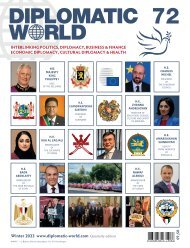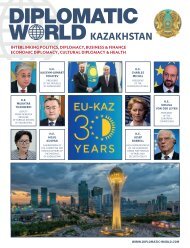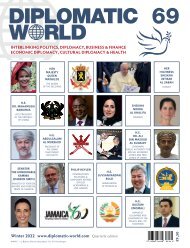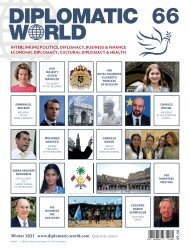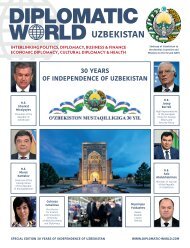Diplomatic World_nummer 57
You also want an ePaper? Increase the reach of your titles
YUMPU automatically turns print PDFs into web optimized ePapers that Google loves.
to modify the initial program without any human control.<br />
Analysts creating algorithms make mistakes and are biased,<br />
since they are human. Their product should be statistically<br />
reliable and fair to all. Only reverse engineering of the<br />
program can reveal its flaws and mistakes. AI is directly and<br />
narrowly target-oriented to anticipate our needs in a strictly<br />
rational and defined way. Computers don’t have intentions;<br />
they repeat and adapt learned patterns. But our intelligence<br />
is profoundly influenced by context and emotion, and<br />
therefore sensitive to nuances and aesthetic awareness.<br />
The major aspect of human perception is its ontological<br />
complexity, beyond the grasp of today’s algorithms and the<br />
understandings of the analysts creating them. The glitches<br />
of AI can have dangerous consequences.<br />
To make AI more sensitive to the complete scope of<br />
human thought requires insight and collaboration with<br />
people with highly specialized domain knowledge. On<br />
the other side, since wellbeing is not an exact science,<br />
the immense variation of individual conscious and nonconscious<br />
requirements will have to be centralized roughly<br />
in a pre-determined number of prototypes. This will lead<br />
to a schematic reduction of human diversity. Orwell is<br />
not far away. How will the deep-learning algorithms adapt<br />
themselves to the real-life circumstances of their targets<br />
without being connected to a refined application of all<br />
fields of cognitive science, sociology, psychology and a final<br />
human control? The simple fact that they modify themselves<br />
continuously to upgrade their performance will make it<br />
nearly impossible to monitor them in real time. No amount<br />
of human ingenuity will eliminate this threat. Moreover, the<br />
main concern is that the analysts, creating AI algorithms,<br />
will not necessarily be motivated by a human-centered<br />
morality. Underrepresented communities will not be taken<br />
into account. The threat of job displacement is real. The<br />
only question is: How much, where and when?<br />
CATALOGUING ART<br />
Collectors are progressively more interested in using the<br />
Internet to manage their collections. According to the Art<br />
Market report (2018) of Art Basel and UBS, online sales<br />
increased 10% year-on-year to $5.4 billion and accounted for<br />
8% of the value of global sales in 2017. Since 2011, ‘Google<br />
Arts & Culture project’ combines AI with image data of<br />
artworks and art historical content. On the basis of selfies,<br />
produced by the social media, it searches their ‘doubles’<br />
in art history, making amazing random connections. It<br />
discovered that the ‘Irises’ of Vincent van Gogh used the<br />
same colour-chromatism palet as the ‘Waterlilies’ of Claude<br />
Monet. Its algorithms classified 30.000 photographs of the<br />
New York MOMA’s exhibition archives since 1929, all the<br />
photographs of TIME magazine, etc. You can search them<br />
with tags such as: love, sorrow, babies, etc. Google Cultural<br />
Institute’s director Amit Sood declared that 1500 museums<br />
and cultural institutions in 70 countries contribute images<br />
(already 6.000.000) to it. The Google Art Camera takes<br />
images in such high resolution that each brushstroke is<br />
visible. It’s the closest one can get to the traditional ‘handson<br />
experience’ of a connoisseur. Its Art & Culture website<br />
produces cultural content in an organized way, gathering<br />
huge social media impact. The cultural world of museums<br />
and collectors is neither organized nor easy accessible,<br />
Google is. Everybody can see the Grand Tour series, the<br />
Horse race in Sienna or stories told by museum curators<br />
about their institution’s works.<br />
In the online art market, buyers want total transparency and<br />
certainty, because the financial services industry looks at<br />
art as an alternative asset class that requires data. Buyers<br />
look for information, but also for expert opinions about the<br />
artness of art and the way social media reflect the art world.<br />
Artsy, claiming 24.000.000 visitors yearly, is a new power<br />
player/matchmaker in the art market. It is a facilitator to<br />
existing trusted brands such as Gagosian Gallery, providing<br />
live-bidding technology. Live video capability is essential to<br />
maintain the feeling of excitement in online auctions. 2.000<br />
galleries around the world publish inventory and exhibition<br />
lists on the site, driving $20 m of monthly sales. Last<br />
year, Artsy acquired ArtAdvisor to lean more heavily on<br />
personalized data to create actionable insights and to create<br />
a better customer experience.<br />
Boston based Invaluable.com, including a vast auction<br />
price database, has monthly more than 5.000 sellers,<br />
3.000.000 visitors and $3 bn in listed items. It acts as a<br />
personal shopper across 5.000 auction houses, going trough<br />
10.000 catalogues. Sales totaled $217 m last year. EBay<br />
and Sotheby’s use Invaluable since 2015. The Dallas-based<br />
Heritage Auctions is the market leader with $348,5 m in<br />
sales last year (2016).<br />
ArtAssistant, developed by the Belgian Alexander Tuteleers<br />
is one single and secure online site for all actors in the<br />
art world. It uses leading edge technology and AI on its<br />
platform, such as Blockchain for transactions. Collectors<br />
need an inventory of their collections. They follow their<br />
117






